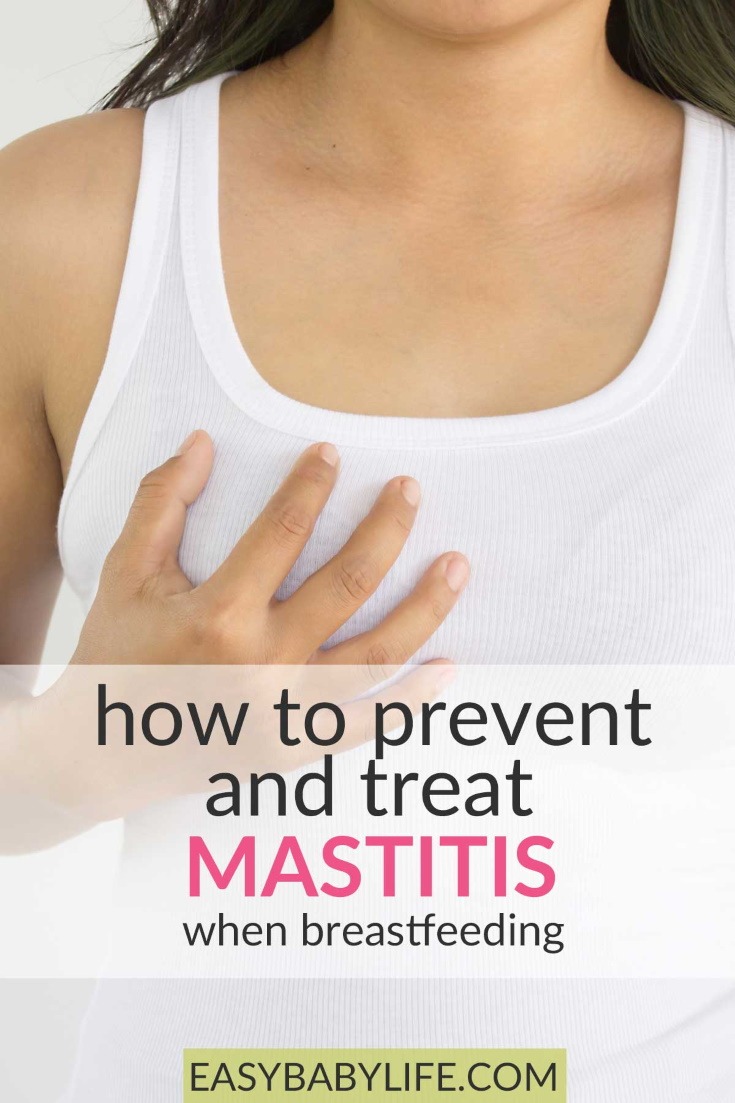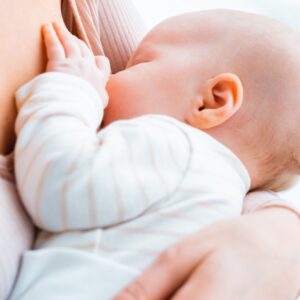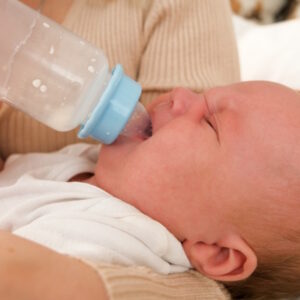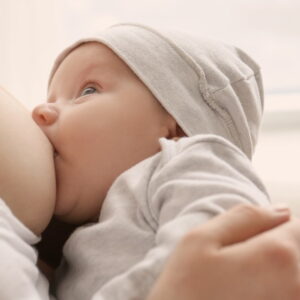Mastitis when breastfeeding is common. It is an inflammation of the breast tissue that sometimes develops into an infection.
Mastitis can be painful. You’ll want to prevent it as much as possible and treat it quickly if you get it.
Let’s go through how to deal with mastitis in the best possible way.

Your Guide to Mastitis When Breastfeeding
In this article…
- What is mastitis?
- What causes mastitis?
- Symptoms
- Can you get mastitis without breastfeeding?
- Other possible diagnoses
- How to prevent mastitis
- I keep getting it. Why?
- Does mastitis go away on its own? What happens if mastitis doesn’t go away with antibiotics or is left untreated?
- Treatments
- How long can mastitis last?
- Can mastitis make a baby fussy?
- When should I call the doctor?
What is Mastitis?
 Mastitis is an inflammation of the breast. It can be seen as swelling, redness, warmth, or tenderness of the breast. Sometimes, milk doesn’t come out properly. It is common during the first six months of breastfeeding, especially from ten days up to six weeks after giving birth.
Mastitis is an inflammation of the breast. It can be seen as swelling, redness, warmth, or tenderness of the breast. Sometimes, milk doesn’t come out properly. It is common during the first six months of breastfeeding, especially from ten days up to six weeks after giving birth.
It is not typically dangerous, but you may feel really sick if it hits you badly. Fortunately, it will go away quickly with the right treatment.
What Causes Mastitis?
Mastitis is commonly due to breastfeeding (so-called lactational mastitis). As many as 20 % of breastfeeding moms develop mastitis at some point, usually during the second to third weeks of breastfeeding.
Mastitis is usually caused by breast engorgement (i.e., swelling breast because it hasn’t been emptied) or cracked skin on or around the nipple (allowing bacteria to enter the milk ducts).
Research indicates that moms had an increased risk of developing mastitis if they reported nipple damage (like cracked nipples), an oversupply of breast milk, use of nipple shields, or expressing breast milk throughout the day.
The presence of bacteria, such as Staphylococcus aureus, Escherichia coli, and Group A streptococcus, on the nipple or in breast milk itself increases the risk of developing mastitis. A fungal infection with Candida albicans is also another possible cause.
Although breast engorgement and plugged ducts are different conditions from mastitis, they are risk factors for developing mastitis.
Other risk factors include the presence of a cleft lip or palate in your baby, a tongue tie in your baby (a short frenulum), difficulties with latching, frequently missed periods for breastfeeding, using a tight bra, and poor nutrition due to the mother’s diet.
Whatever you do, unless your doctor explicitly advises you to, don’t stop breastfeeding if you suspect that your breast is infected! Things will only worsen, and breastfeeding helps the condition clear up.
Mastitis Symptoms
The American Academy of Pediatrics and the American College of Obstetrics and Gynecology note that some characteristics of mastitis are the following:
- sudden development of symptoms
- usually affects one breast most of the time
- warm to touch, red and swollen
- intense breast pain, but only on a certain area (localized)
- fever (101°F (38.4 C) and higher)
- flu-like symptoms may be present (body weakness, chills, nausea, vomiting)
If you’re nodding your head in agreement and cursing while reading this, chances are you have mastitis.
Since antibiotics are often necessary, it is best to consult your doctor as soon as possible but continue breastfeeding on the affected breast.
Later on, you’ll likely be an expert in acting quickly at the early warning signs and treating mastitis naturally, reducing the risk of a serious infection.
If you have shooting pain in your breast and no lumps, you may have a yeast infection called breast or nipple thrush, which you can read about here.
Can you get mastitis without breastfeeding?
Yes, it’s possible to have mastitis even if you aren’t breastfeeding and even if you haven’t recently given birth. It can also develop in men!
Some causes of nonlactational mastitis include breast implants, nipple piercing, smoking or nicotine addiction, eczema, diabetes, chronic infections like tuberculosis, people who have lumpectomies with radiotherapy, and those who have a weakened immune system (immunocompromised).
Other possible diagnoses
Mastitis is often confused for breast engorgement or plugged milk ducts.
In breast engorgement, symptoms gradually develop, and both breasts are usually involved. There’s pain, swelling, and warmth, although the fever is low-grade (less than 101°F), and moms usually feel well.
In plugged milk ducts, symptoms also gradually develop and are commonly seen after breastfeeding periods. Like mastitis, it affects one breast only, but the pain is mild and sometimes tolerable. Fever episodes barely reach above 101°F, and like engorgement, moms don’t feel too ill.
How can you tell the difference between mastitis and breast abscess?
Breast abscesses develop when mastitis is not diagnosed or treated quickly – it’s a recorded complication in up to 11% of lactating moms.
Breast abscesses are also painful and present with fever and body weakness. The breast is swollen, red, and tender as well. What sets this apart is the development of a lump that feels fluid-filled (called fluctuation). Moms may also feel enlarged lymph nodes near the armpit area.
How to Prevent Mastitis
There are some things that you can do to prevent mastitis when breastfeeding.
Double-check the breastfeeding position, latch, and timing
Check if there are any issues with breastfeeding. You can set an appointment with a lactation consultant to double check any problems with your breastfeeding position, your baby’s position, the latching and unlatching process, and timing (including night feedings).
Take care of plugged ducts
Ensure you take care of any blockages or plugged ducts immediately. Having an obstruction will keep your milk from flowing properly, and this can lead to mastitis. Plugged milk ducts feel like lumps that are just beginning to be tender. Feed your baby more frequently or pump milk out while gently massaging the lumps. You can also take a warm bath or shower.
Frequent feeding
Feed your baby regularly and frequently. You don’t need to limit the feeding times or have a set feeding schedule. Although the expected breastfeeding duration is 10-15 minutes per breast, you may continue feeding your baby until they stop sucking. You can also try feeding them when you feel your breasts getting full. Lastly, watch out for your baby’s hunger cues. You shouldn’t wait until your baby is screaming like a banshee.
A breastfeeding position to mitigate lumps
A great little trick I learned from my midwife was to place your baby so that his cheek was in the same direction as the most painful lump in your breast. This way, he or she will primarily suckle the clogged milk ducts. This trick works both for preventing engorgement and mastitis as well as treating these conditions.
Prevent nipple cracks
Prevent your nipples from cracking or damage. Keep lanolin ointment on hand for nipples, or apply some breast milk after feedings. Let your nipples dry before covering up again. This will reduce cracks and sores that might be an entry point for infection.
Watch out for cold draft
While it hasn’t been scientifically proven, many moms claim that exposing their breasts to cold draft is a certain way to get this breast infection. Something to think about, particularly when breastfeeding outside. Wear a blanket and find shelter from the wind.
I Keep Getting Mastitis. Why?
There are a couple of reasons why you might have recurring mastitis.
One of them could be from not feeding or pumping regularly. If you are supplementing breastfeeding with bottle feeding, you may increase your chances of developing this condition. When your breasts feel full, pump the milk out (you can store your milk for future use) or feed your baby to reduce the chances.
Also, it might be an indication that your immune system is a bit run down. You may need to take extra good care of yourself in terms of nutrition, sleep, and rest. It is great to focus a lot of attention on your baby, but for your baby to stay healthy, you must stay healthy as well.
Does Mastitis go away on its own? What happens if mastitis doesn’t go away with antibiotics or is left untreated?
Mastitis most often doesn’t go away on its own. It should be treated with antibiotics. If left alone (or without medical management), it could lead to complications, such as breast abscesses. These are harder to treat and may need special procedures to be managed well, like drainage or surgery.
One rare cause of persistent mastitis is inflammatory breast cancer. This is why it’s important to be checked by a healthcare provider – to avoid the development of these conditions and to quickly diagnose and manage them should they appear.
How to treat Mastitis
So how do you actually treat mastitis? Managing mastitis involves a combination of both medical and non-medical remedies:
Continue breastfeeding
The most effective thing for mastitis is to continue breastfeeding your baby (make sure that your breastfeeding technique is correct, though!). This will help the illness resolve and reduce the chance of further complications. Start with the other breast if the infected one hurts too much or if your baby rejects the infected breast.
As described above, make sure that your baby suckles so that his or her cheek is as close as possible to the tender lump. Do this even if your baby has to have their feet against your forehead or some other weird position. Lie down on your side if you have to and ask someone to help you place your baby in the right position.
Selfcare and pain killers
Take care of yourself. Drink lots of fluids and get some valuable time to rest. Take acetaminophen or ibuprofen for fever and pain. These are fine for taking while you’re breastfeeding and can help you feel a little better.
Antibiotics
Antibiotics are often essential to treat mastitis: your doctor or healthcare provider will prescribe the most commonly used antibiotics for mastitis. If necessary, they may request a culture of expressed milk to determine the specific bacterial cause of mastitis. This way, they can adjust the antibiotic if needed.
If antibiotics are prescribed, make sure to complete your full course of antibiotics even if you start feeling better.
Sleep without a bra
If possible, if your breasts don’t leak too much, consider sleeping without a bra, and don’t sleep on your stomach (even after the pain has started to fade away).
Gentle massage
According to La Leche League International, gently massaging the lumps while taking a warm shower or while breastfeeding can help. Then, you can apply ice packs after feedings.
Warm compresses
Another remedy is to apply a warm or slightly hot compress to the affected breast before breastfeeding starts. Some mothers soak their breasts in a tub or basin of warm water for 10 minutes three times a day.
These remedies and rest should help your mastitis go away quickly and without further complications.
How long can mastitis last?
As long as mastitis is treated properly, it can typically last for up to 5 days, according to the Children’s Hospital of Philadelphia. However, symptoms lasting for 10 days or even up to three weeks are possible.
Can mastitis make a baby fussy?
Usually, babies can continue feeding with the infected breast. However, some babies notice a change in the taste of the milk, but this doesn’t mean it’s dangerous to feed them breastmilk. If you find your child fussy, feed them with the unaffected breast, and focus on draining milk from the infected one.
When Should I Call the Doctor?
First, you should contact your doctor when you get symptoms to make sure the mastitis is properly diagnosed and treated.
Then, you may need to get in touch with your doctor if the condition worsens or if you feel like you are getting worse and not better. If your symptoms are getting worse despite medical treatment, you should call your doctor.
This breast infection really isn’t fun at all. But most moms become less prone to get it over time and also become more skilled in stopping it before it turns really bad.
If you are suffering from mastitis when breastfeeding or have tips on how to treat mastitis at home, please share your experiences in the Comments section below.
Related Breastfeeding Info
- Nipple Thrush Symptoms, Prevention, And Treatments
- Breastfeeding Latch Video Gallery
- Baby Thrush Causes, Symptoms And Treatments
Research References for Mastitis when Breastfeeding
- Lactational mastitis and breast abscess
- Determinants of mastitis in women in the CASTLE study: a cohort study
- Breastfeeding Handbook for Physicians
- Benign Breast Conditions
- Management of Mastitis in Breastfeeding Women
- Breast Infections and Inflammations
- Management of Lactational Mastitis and Breast Abscesses: Review of Current Knowledge and Practice
- Comparative Study of the Use of HPA Lanolin and Breast Milk for Treating Pain Associated with Nipple Trauma
- Blocked milk ducts, mastitis and breast abscess
- Breast Mastitis

Paula Dennholt founded Easy Baby Life in 2006 and has been a passionate parenting and pregnancy writer since then. Her parenting approach and writing are based on studies in cognitive-behavioral models and therapy for children and her experience as a mother and stepmother. Life as a parent has convinced her of how crucial it is to put relationships before rules. She strongly believes in positive parenting and a science-based approach.
Paula cooperates with a team of pediatricians who assist in reviewing and writing articles.







The best trick I learned (and I have tried everything!) was to use a – this is going to sound really weird – a vibrator on my breast. I have a back vibrator that I got at Rite Aid and every time I have a lump I get it out and vibrate the lump and it usually goes away within the day. It looks ridiculous and my husband makes fun of me but it works! You can also use the bottom of an electric tooth brush!
Thanks for this helpful tips on treating mastitis, you can also try taking in probiotics. There’s probiotics called qiara that is proven and tested by many. Thank you